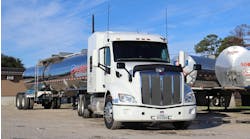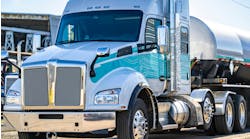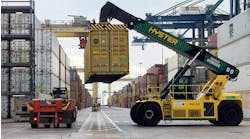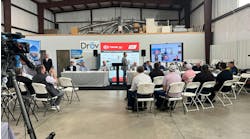Liquid bulk shippers, intermodal supply-chain stakeholders convene for ITCA’s 2021 event
KEMAH, Texas—Carbon counts are coming.
They’re already here for companies with operations in Europe, as businesses around the world face increasing regulatory pressure to reduce the production of greenhouse gasses that contribute to climate change. And Jonathan Arneault, CEO of FuelTrust, says legislation currently making its way through Congress will force U.S.-based companies to begin accounting for their total CO2 emissions as early as next year.
“There is a piece of legislation that is almost guaranteed to pass, which will say every part of the logistics lifecycle, including everyone within the logistics supply chain—if you handle cargo, if you transport cargo, if you are the custodial manager of cargo, or if you are a producer of cargo—will have to give a carbon report.
“How? Do you know how to give a carbon report, do you know how to measure carbon, do you have any idea what a carbon report is?
“That’s a problem.”
Arneault was one of three guest speakers at the Intermodal Tank Container Association’s 2021 Intermodal Bulk Liquid Symposium held Nov. 11 at Sundance Grill II in Kemah, Texas, along with Bruce Mann, the director of freight mobility for the Port of Houston Authority, and Brian McCracken, a senior manager with The Greenbrier Companies.
They were the first Symposium speakers in two years after ITCA last year was forced to forego presentations due to the pandemic, and instead hosted only the annul golf outing and an outdoor gathering. And members clearly were happy to see speakers return as nearly 150 attendees packed into the venue’s meeting room.
Frieda Lolley, ITCA president, said approximately 200 were at the post-Symposium industry reunion. (View the media gallery to see images from the Symposium, and the golf tournament held a day earlier at the Bay Forest Golf Course in La Porte.)
ITCA was established as a networking event for the intermodal bulk liquid industry. The Symposium typically highlights news and trends within the intermodal industry, and business leaders from all over the world convene to collaborate with key executives representing shippers, ports, rails, truckers, depots, cleaning facilities, leasing companies, tank operators, surveying companies, ocean carriers and freight forwarders.
Carbon concern
In his presentation “The Carbon Concern,” Arneault stressed the increasing importance of accurate emissions measurements as governments around the world begin to implement carbon taxes across the supply chain.
“It is a concern,” he said. “You don’t get to hide from it.”
Arneault highlighted a recent decision by a Netherlands court ordering Shell to reduce the CO2 emissions generated by its business relations, including suppliers and end users, by 45% (compared to 2019 levels) by 2030.
“Shell doesn’t sell to end consumers,” he said. “There are 15 to 20 different custodial parties between the time (Shell product) leaves the last place at Shell until it gets into your gas tank, and yet Shell is being ordered to measure what comes out of your tailpipe.”
And that’s not all.
Like Shell, U.S. companies will be tasked with tracking the emissions generated by everyone in their supply chains, Arneault said, and then adding them up to produce a “carbon score” on which they will be taxed.
Emissions that must be accounted for include Scope 1-3 emissions. Scope 1 emissions are emissions directly produced by the company, its vehicles, and facilities; Scope 2 emissions are produced by the company’s energy suppliers, and Scope 3 emissions include those produced by a company’s entire supply chain, services chain, delivery chain, and end-consumer customers.
Approximately 80% of a company’s environmental, social, and governance (ESG) footprint consists of Scope 3 emissions, Arneault said.
“Did you put your tank container on a train?” Arneault said. “Well, how much did that train produce? If it went onto a ship, and then onto a train, and then onto an 18-wheeler, how much did they produce? And what was the final destination?
“So how are you going to account for all this?”
“This is coming. It will be confusing, it will be highly bureaucratic, it will be a political fight—and you will lose. You don’t get to say no to government. There are too many different players that have been at this for about 50 years, and they have finally gotten it through.”
Overarching impact
Carbon, or ESG, scores won’t only impact reporting to the federal government. They will also affect trade financing, insurance and underwriting, compliance verification, carbon taxes and reporting costs, and reputation and share price.
- Trade financing: Even a powerful financial institution like Deutsche Bank, the largest private bank in the world, will not fund companies that do not have an ESG score, Arneault said.
- Insurance and underwriting: Insurers also will stay away from companies without ESG scores. “They are seeing the potential lawsuits that will come 20 to 25 years from now, or sooner, as major risks, so they will want validation and records for corporate insurance and underwriting, and cargo underwriting,” he said.
- Compliance verification: This is hugely expensive in Europe, where carbon taxes are estimated to be 6% of the cost of logistics, as well as a paperwork nightmare, and “it’s coming to America,” Arneault asserted.
- Carbon taxes and reporting costs: FuelTrust’s first market for carbon measurements is in bunker fuels for vessels, which account for 8% of the fuel market. Arneault said regulators want a 125% tax on those fuels, and plan to levy similar taxes on trains and trucks. “Just last month, we had our first major train company, here in the Eastern U.S., call and say, ‘How can you help us?’” he said.
- Reputation and share price: Annual reports, overseas and, in some cases, already here in the U.S., typically feature ESG scores and improvements, which often are measured around CO2 emissions, and these scores, Arneault argued, impact a company’s reputation, share price, and ability to attract investors.
Avoid over-estimation
Various organizations, like the Environmental Protection Agency in the U.S., and the European Union overseas, provide calculators that allow companies to estimate their carbon production. The scores they produce “are a lie,” Arneault said.
By his estimation, 95% of all Scope 1-3 emissions are over-estimated or duplicative.
That’s because the calculators, or other forms of estimation, overinflate the numbers at every step in the supply chain, compounding the imprecisely generated “guesstimates” that don’t accurately measure real emissions. “By the time it gets to your container yard, and you have a lift truck you’re trying to measure, it already has an 80% burden, including everything that came before it—and 50% of that burden never happened.”
Other calculators and systems are available that are more accurate, Arneault said, but still rely on estimation.
So he recommends a more measured approach.
FuelTrust uses a patented artificial intelligence-powered “digital chemist” that analyzes the unique batches of fuel consumed by power plants, cargo ships, trains, and other supply-chain stakeholders, and generates a digital twin that isolates every molecule within the fuel, and simulates chemical combustion. “We have a digital twin of the engine, and we say, ‘This is the exact makeup of that batch of fuel they pulled out of the ground, or out of the tank, and at these RPMs, for this long, this is its emissions output, and scientifically, this is how it happens.’”
The result is greater “GHG truth, transparency, and visibility,” Arneault said.
Companies then can use these scientifically validated emissions reports, generated without adding sensors, to reduce taxes inflated by overestimation. So, whether it’s with his company—FuelTrust plans to begin looking at railroads next year and, eventually, trucks—or another service provider, Arneault said businesses must add this capability sooner than later, and insist that their supply-chain partners do so as well.
“Plan for it in the next upgrade to your transportation and logistics management systems,” he said.
“This is coming, and there will be a dozen companies in your business trying solve this problem, so look for the right partners and choose well.”
Arneault also recommended reducing the coming “paperwork nightmare” by utilizing blockchain technology to store documents in a safe and secure network accessible to all parties. With blockchain, records can’t be altered or deleted, and only can be viewed by the custodians who need to see them. “Your trade information is secure, and yet all the parties who are allowed to see it can see it, where they need to,” he explained.
Bottom line: “If you can’t validate, it will be prohibitively expensive to operate,” Arneault said.
“You can argue all day, but if you can’t prove it, you pay.”
Port of Houston
Mann’s presentation included information about the Port of Houston’s history, and current activities and initiatives. Here are some highlights:
- The Houston Ship Channel is home to the largest petrochemical complex in the U.S. Houston also has the largest energy pipeline and storage network in the U.S., with 500 million barrels of liquid storage along the Houston Ship Channel. A total of 74% of cargo on the Houston Ship Channel is liquid bulk. The channel has a $339 billion economic impact in Texas, and an $802 billion impact across the U.S.
- Total Post of Houston container volume, along with exports of crude oil, polyethylene, and propane, all have increased since 2018, although crude oil exports declined from 2020 into 2021, to about 2 million short tons monthly.
- Thirty-seven percent of the containers that pass through the Port of Houston either come from or are heading to East Asia. The rest involve Europe/the Mediterranean (26%), Latin America (21%), the Indian subcontinent/Middle East (12%), and “others” (4%).
- The Port of Houston handles approximately 3 million containers per year. The No. 1 container exporter in 2020 was ExxonMobil, with 46,858 twenty-foot equivalent units (TEUs) shipped out. Dow (19,737 TEUs) was a distant second. The No. 1 importer was Wal-Mart (17,407) and, surprisingly, No. 2 was Red Bull North America (13,306).
- Hardware and construction materials were the most imported commodities by volume in 2020, with 211,711 TEUs moved. Food and drink (187,239) were second, chemical and minerals were seventh (82,166), and plastics and resins (78,882) were eighth. Conversely, plastics and resins (519,873) were the most-exported commodity, chemicals and minerals (234,241) were second, and food and drink (73,999) were fourth.
- “Project 11” is the port authority’s “most ambitious expansion initiative yet.” The expansion, a $1 billion partnership between public and private entities, seeks to better accommodate vessels that are growing in size by widening much of the federal ship channel from 530 feet to 700 feet, and making other enhancements, by 2025. Visit expandthehoustonshipchannel.com for more information.











